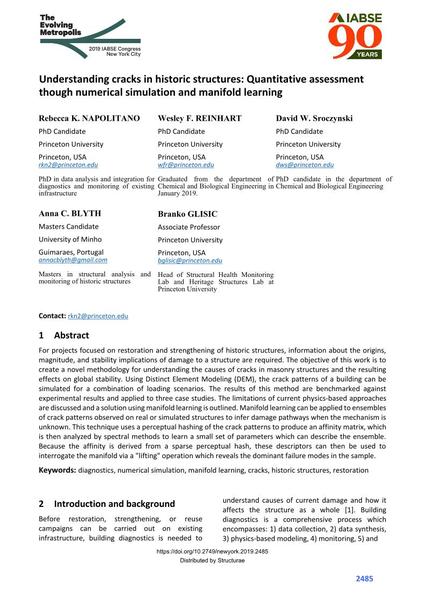Understanding cracks in historic structures: Quantitative assessment though numerical simulation and manifold learning

|
|
|||||||||||
Bibliographic Details
| Author(s): |
Rebecca K. Napolitano
(Princeton University)
Wesley F. Reinhart (Princeton University) David W. Sroczynski (Princeton University) Anna C. Blyth (University of Minho) Branko Glisic (Princeton University) |
||||
|---|---|---|---|---|---|
| Medium: | conference paper | ||||
| Language(s): | English | ||||
| Conference: | IABSE Congress: The Evolving Metropolis, New York, NY, USA, 4-6 September 2019 | ||||
| Published in: | The Evolving Metropolis | ||||
|
|||||
| Page(s): | 2485-2491 | ||||
| Total no. of pages: | 7 | ||||
| DOI: | 10.2749/newyork.2019.2485 | ||||
| Abstract: |
For projects focused on restoration and strengthening of historic structures, information about the origins, magnitude, and stability implications of damage to a structure are required. The objective of this work is to create a novel methodology for understanding the causes of cracks in masonry structures and the resulting effects on global stability. Using Distinct Element Modeling (DEM), the crack patterns of a building can be simulated for a combination of loading scenarios. The results of this method are benchmarked against experimental results and applied to three case studies. The limitations of current physics-based approaches are discussed and a solution using manifold learning is outlined. Manifold learning can be applied to ensembles of crack patterns observed on real or simulated structures to infer damage pathways when the mechanism is unknown. This technique uses a perceptual hashing of the crack patterns to produce an affinity matrix, which is then analyzed by spectral methods to learn a small set of parameters which can describe the ensemble. Because the affinity is derived from a sparse perceptual hash, these descriptors can then be used to interrogate the manifold via a "lifting" operation which reveals the dominant failure modes in the sample. |
||||
| Keywords: |
restoration numerical simulation diagnostics cracks historic structures manifold learning
|
||||
